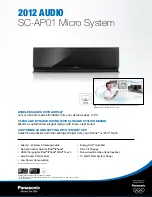
(5)
WILL PREVENT SIGNAL OVERLOAD AND DECREASE DISTORTION. ONCE
YOU HAVE MODIFIED YOUR SOUND AND WOULD LIKE TO INCREASE THE
OUTPUT OF YOUR SOUND, THEN YOU MAY ADJUST THE ROTARY GAIN
CONTROL IF NEEDED.
5.
KILLING FREQUENCIES:
There are two ways to kill, or can-
cel out, frequencies, only on
CH2
(36) and
CH3
(43), using the
LOW
,
MID
, and
HIGH KILL SWITCHES
(59, 60). Each
KILL
SWITCH
has
3
positions:
LATCH
,
NORMAL
&
FLASH
. When
you move the selected
KILL SWITCH
to the top
LATCH
(
ON
)
position, the switch will stay there, and the frequency will be
killed. When you move the selected
KILL SWITCH
to the center
position the kill function is not active, and the frequency will not
be killed. When you move the selected
KILL SWITCH
to the bot-
tom
FLASH
position and hold it there, the frequency will be
killed. Releasing the selected
KILL SWITCH
from the bottom
position will bring it back to the center position and the frequen-
cy will no longer be killed.
6.
CUE:
By connecting a set of headphones to the
HEAD-
PHONE
(22) jack, you can monitor any or all channels. Press
the
CUE BUTTONS
(28, 35, 42) for
CH1
through
CH3
to assign
the
CH
(s) to be monitored in your headphones. The respective
CUE LED
indicators will glow when in use. Use the front panel
located rotary
CUE VOLUME CONTROL
(44) to adjust the
CUE
volume without changing the overall mix. By turning the front
panel located
CUE/MIX/PGM
(45) rotary control counter clock-
wise you will be able to monitor the assigned
CUE
signal. Slowly
turning the control clockwise to middle position (
MIX
) allows you
to monitor
CUE
mix with
PGM
. Moving the control clockwise to
the right allows you to monitor
PGM
output.
Use the
CUE SPLIT/MIX SWITCH
(48) to split the audio input
playing in your head phones. When the
CUE SPLIT/MIX
SWITCH
(48) is in
MIX
mode you will only be able to monitor
your
CUE
in both headphones, when the rotary
CUE/MIX/PGM
CONTROL
(45) is in
CUE
. When the
CUE SPLIT/MIX SWITCH
(48) is in
SPLIT
, you will notice one side of your headphones will
play your
CUE
and the other side will play
PGM
, thus enabling
you to monitor both outputs separately. This feature will only
work properly if the
CUE/MIX/PGM
(45) rotary control is placed
at noon or middle position. If the
CUE/MIX/PGM
(45) rotary con-
trol is set to
CUE
you will only here the
CUE
signal playing on
the left side of your headphones. If the
CUE/MIX/PGM
(45)
rotary control is set to
PGM
, the
PGM
will be the only signal
heard from the right side of your headphones.
7.
CROSS FADER SECTION:
The
CROSS FADER
(46) allows
you to mix from one source to another. The
CROSS FADER
(46)
in your unit is removable and if the need arises can be easily
replaced. Your
Gemini
mixer comes with a
RG-45
(
RAIL-
GLIDE™
)
DUAL-RAIL CROSS FADER
.
RAIL GLIDE™
CROSS FADERS
have internal dual stainless steel rails that
allow the slider to ride smoothly and accurately from end to end.
Also available is our
RG-45 PRO
(
PROGLIDE™
)
Dual-Rail
CROSS FADER
. This unique
CROSS FADER
features, a spe-
cial curve designed for scratch mixing. Just purchase one from
your
Gemini
dealer and follow the instructions:
NOTE: DO NOT APPLY PRESSURE WHILE USING THE CROSSFADER.
LIGHTLY GLIDE THE CROSSFADER BACK AND FORTH. PRESSING DOWN
ON THE CONTROLS CAN BEND CONTACTS AND CAUSE A LOSS OF
SOUND.
8.
SLOPE CONTROL:
The
CROSS FADER SLOPE SWITCH
(57) allows you to adjust the kind of curve the
CROSS FADER
has. Flip the
CROSS FADER SLOPE SWITCH
(57) down to
make the slope steep and cutting (perfect for scratching). Flip
the
CROSS FADER SLOPE SWITCH
(57) up to make the slope
gradual and gentle.
9.
REVERSE CONTROL:
The
CROSS FADER REVERSE
SWITCH
(56) allows you to reverse the
CROSS FADER
so that
the right side
CH2
(36) or
CH3
(43) is controlled by the left side
of the
CROSS FADER
(46) and the left side
CH1
(29) or
CH2
(36) is controlled by the right side of the
CROSS FADER
(46).
Flip the switch up to activate the
REVERSE
(56) control. Flip the
switch down to deactivate the
REVERSE
(56) control.
NOTE: WHEN THE CROSSFADER REVERSE SWITCH (56) IS ACTIVATED,
ONLY THE CROSSFADER REVERSES. THE CHANNEL SLIDES, GAIN, KILL
SWITCHES AND TONAL CONTROLS DO NOT REVERSE.
10.
CROSS FADER ASSIGN:
The
CROSS FADER ASSIGN
SWITCH
(58) is used to place
CH
(s) on either side of the
CROSS FADER
(46). When the
ASSIGN SWITCH
(58) is in the
top position,
CH1
(29) &
CH3
(36) are assigned to the
CROSS
FADER
(46). When the
REVERSE
(56) control is not activated,
CH1
(29) will be on the left and
CH3
(43) will be on the right.
When the
ASSIGN SWITCH
(58) is in the bottom position,
CH2
(46) &
CH3
(54) are assigned to the
CROSS FADER
(46). When
the
REVERSE
(56) control is not activated,
CH2
(36) will be on
the left and
CH3
(43) will be on the right.
11.
OUTPUT SELECTION CONTROL:
Once you are comfort-
able with the sound level of your music you may adjust the vol-
ume with the
MASTER
(47) slide control. You may adjust the
volume of the zone output with the
ZONE
(51) rotary control. You
may also pan the audio output from left to right with the
BALANCE
(52) rotary control.
12.
MIC SECTION:
Plug your main
MIC
into the
MIC
(21)
1/4"
input located on the front panel. Connecting a microphone to the
1/4" MIC JACK
(21) allows voice amplification through the
mixer to the stereo through the
MASTER RCA
(5),
ZONE
(6),
BALANCED
(8) and
REC
(7) outputs. This
MIC
is controlled by
the
MIC VOLUME
(55),
HIGH
(53),
LOW
(54) rotary controls. To
activate this section, raise the level of the
MIC VOLUME
(55).
The rotary knob will click and a green
LED
will light up to indi-
cate that the
MIC
(21) is in use.
13.
VU METER:
The
PS-02
has a dual mode
VU METER
(50)
that allows you to monitor the decibel levels of
CUE
and
PGM
or
LEFT
and
RIGHT
stereo levels of the
MASTER
output. With the
VU MODE SWITCH
(49) you may monitor the output level of the
CUE
and
PGM
when the switch is
UP
. When this mode is
engaged the
CUE
will be located on the left of the
VU METER
,
while the
PGM
will be located on the
RIGHT
. Or you can moni-
tor the
LEFT
and
RIGHT
stereo decibel levels of the
MASTER
OUTPUT
when the switch is in the
DOWN
position.
INPUTS:
Phono..................................................................3 mV, 47 KOhm
Line.................................................................150 mV, 27 KOhm
MIC ……………..……........................1.5 mV, 1 K Ohm Balanced
MIC Bass..........................................................................± 12dB
MIC High...........................................................................± 12dB
OUTPUTS:
Amp/Zone........................................................0 dB 1V, 400 Ohm
Max.................................................................20V Peak-to-Peak
Rec....................................................................225 mV, 5 KOhm
Balanced Master…..................................……….....2V, 400 Ohm
GENERAL:
Frequency Response................................20Hz - 20KHz +/- 2 dB
Distortion.........................................................................< 0.02%
S/N Ratio.........................................................Better Than 80 dB
Headphone Impedance...................................................16 Ohm
Power Source.......................................115/230V, 60/50Hz, 20W
Unit Dimensions..............................................10" x 3.3" x 11.9"
………………………………………................(254 x 84 x 303mm)
Weight...............................................................7.45 lbs (3.38 kg)
SPECIFICATIONS SUBJECT TO CHANGE WITHOUT NOTIFICATION FOR
IMPROVEMENT.
P
PS
S-0
02
2
P
PS
S-0
02
2
SPECIFICATIONS:
REPLACEABLE CROSS FADER
1. UNSCREW THE OUTSIDE FACE PLATE SCREWS ON THE LOWER HALF OF
THE MIXER. REMOVE THE FADER CAPS AND FACE PLATE.
2.UNSCREW THE FADER (B)
SCREWS. DO NOT TOUCH INSIDE
SCREWS (C). CAREFULLY
REMOVE OLD CROSS FADER AND
UNPLUG CABLE (D).
3. PLUG IN THE NEW CROSS
FADER INTO CABLE (D) AND
PLACE BACK INTO MIXER.
4. SCREW THE CROSS FADER TO
MIXER WITH THE FADER PLATE
SCREWS (B).
5. REPLACE THE LOWER HALF
FACE PLATE AND SCREW TO THE
MIXER.
Содержание PS-02
Страница 3: ... 3 PS 02 FACE FACE Front REAR Front REAR ...






























